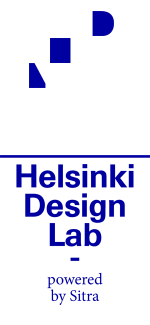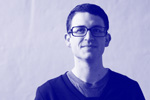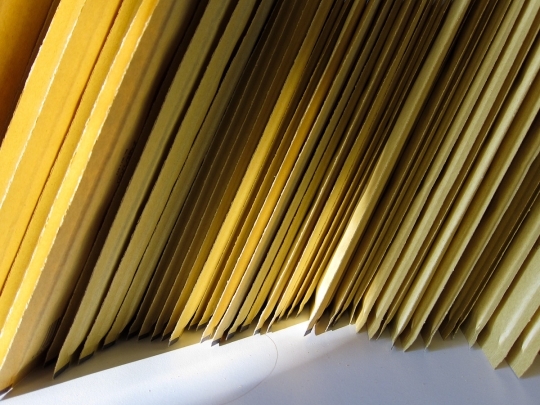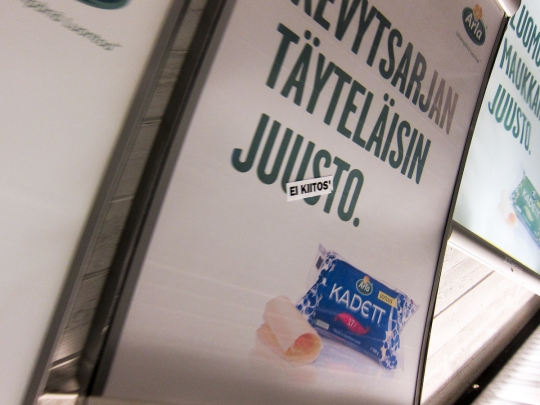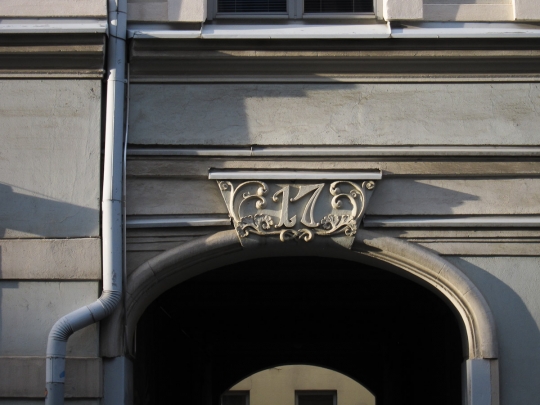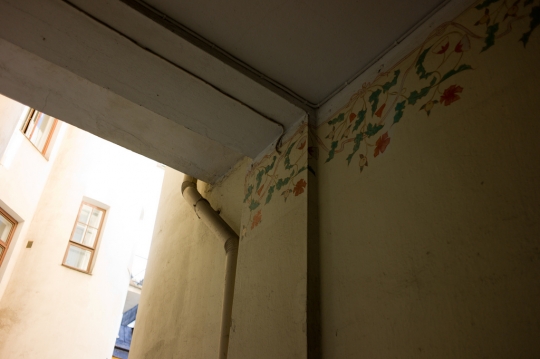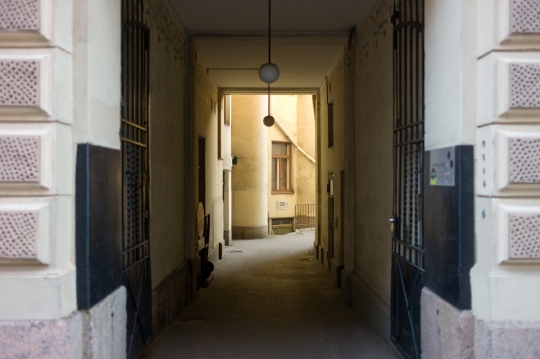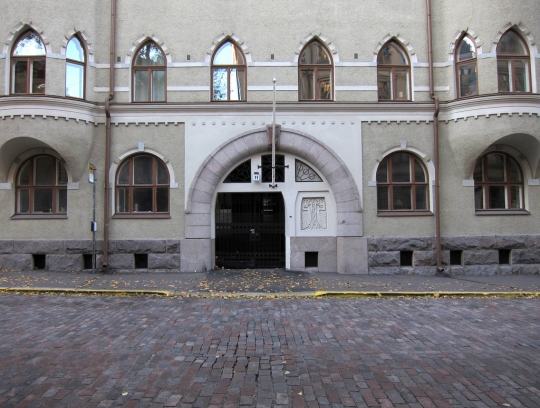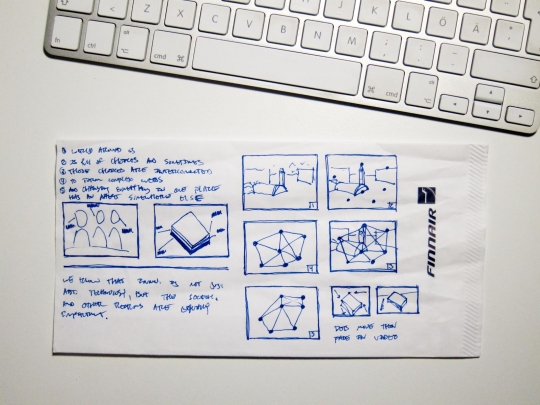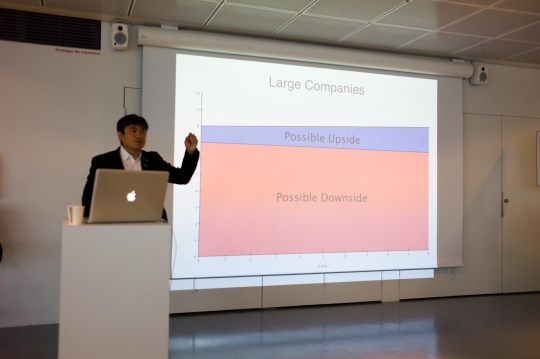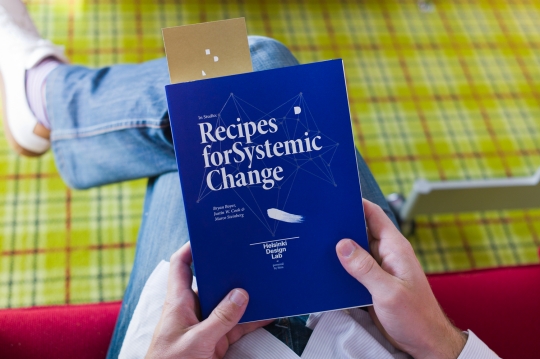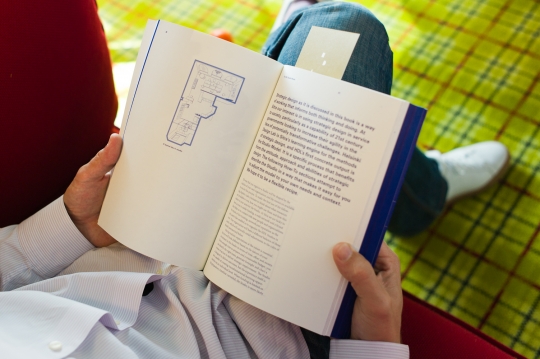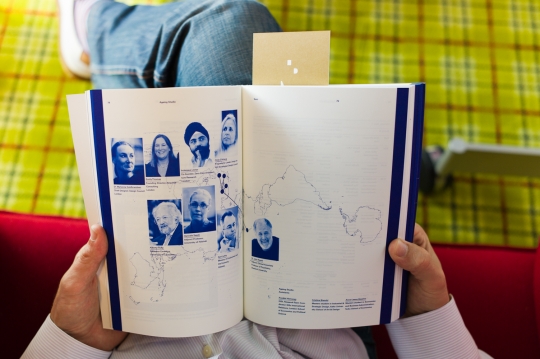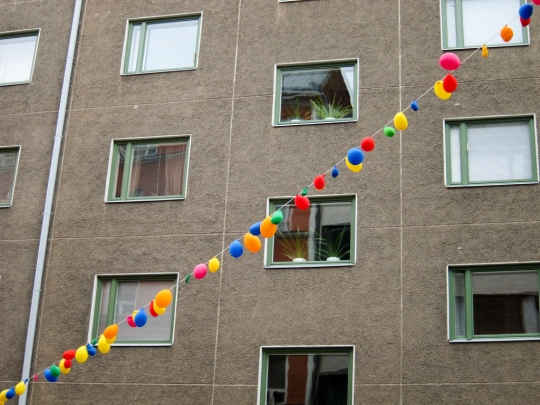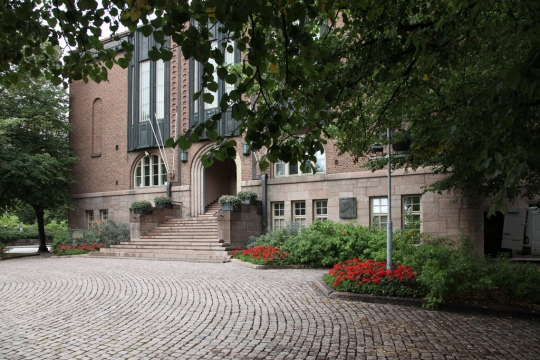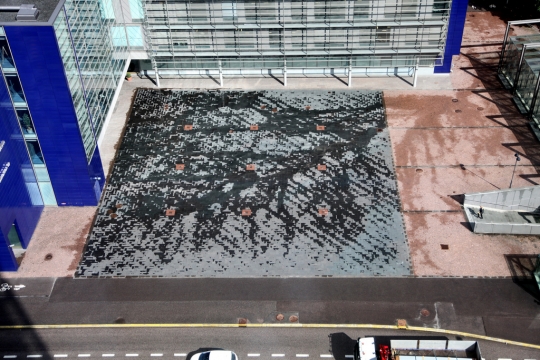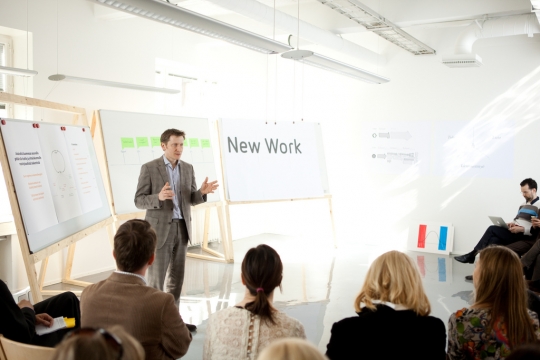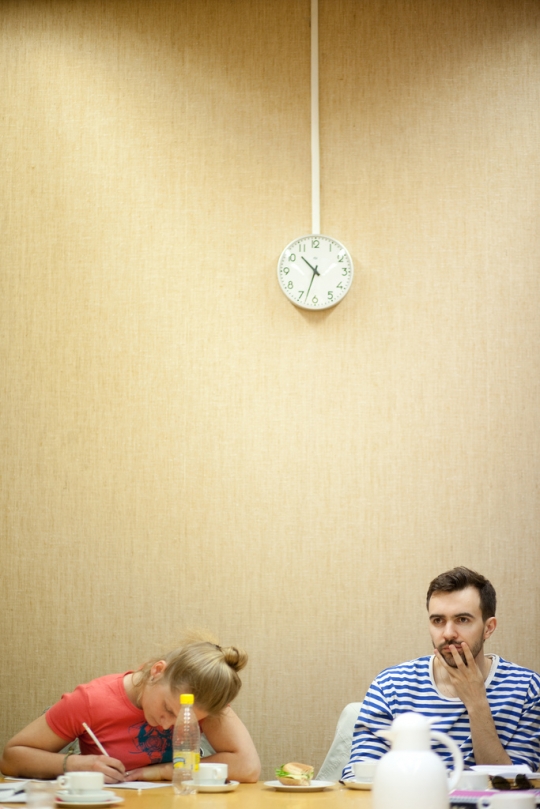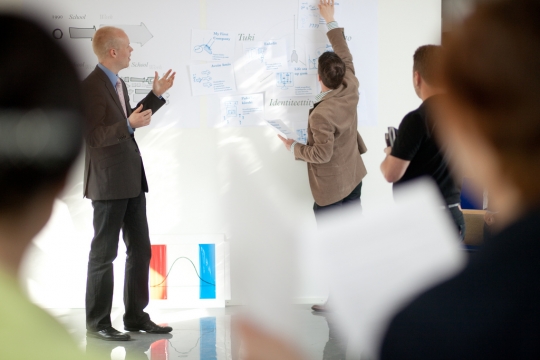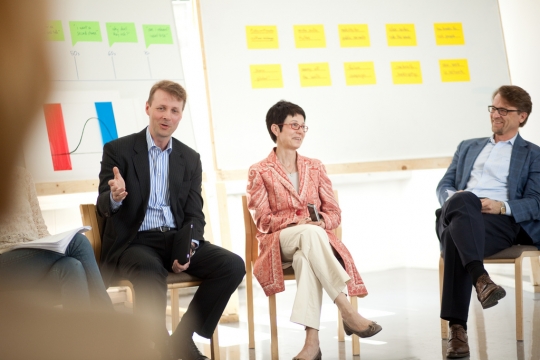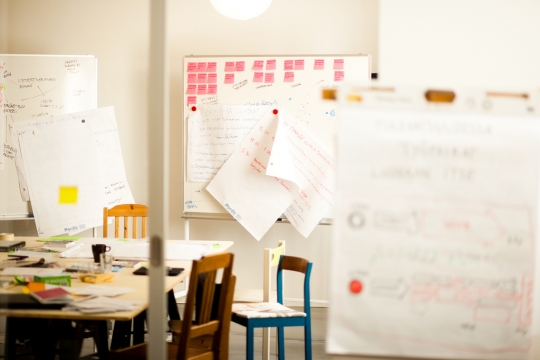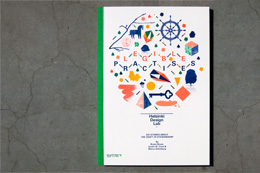All posts by Bryan Boyer
Logistics first: Justin and I were in the office all week; Dan spent half of it in Tallinn presenting at Creative Entrepreneurship for a Competitive Economy; and Marco was around until today, when he left for Tapiei to give a pair of talks at the IDA World Congress. This upcoming week Justin will be at the Design Management Institute event in New York and I will be at CMD in Buenos Aires to give a presentation there. We all have some copies of the book in our luggage, so say hi if you want one.
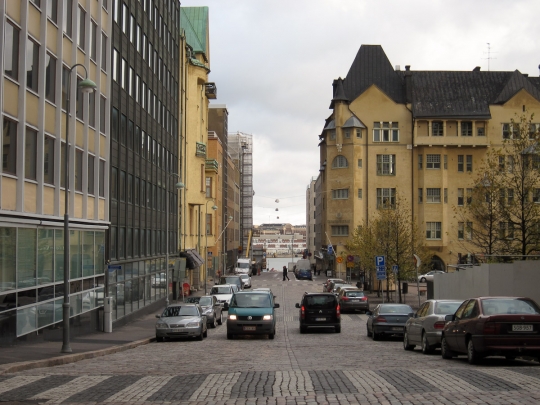
Fall in Helsinki's Kaartintori
Back at home, we enjoyed hosting Norway's Agency for Public Management and eGovernment (Difi) who came to visit on Thursday. Together with Sitra colleagues Sari, Ossi, and Marja we had a good conversation about the challenge of balancing the need to change public sector culture with the realities of having to do so in a non-disruptive way. This conversation echoed some of the things we discussed in our meeting with the UK Cabinet office mentioned here, as well as the general tone of MindLab's How Public Design? seminar in September.
Budgeting exercises continue, as does the ongoing process of shaping a portfolio of projects for 2012. More about this when we have something stable to share.
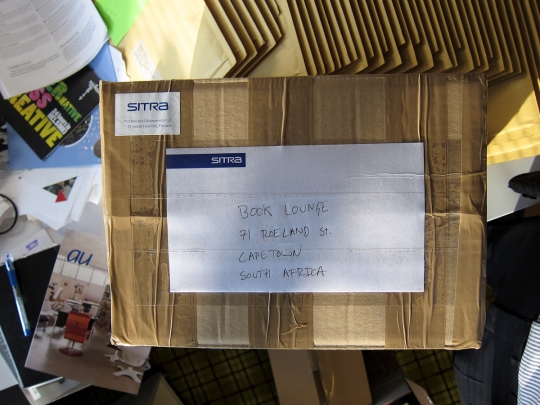
I had a fight with the label printer and it won
We're happy to announce that we've added two more bookshops to our fledgling distribution network for the book. Booklounge in Cape Town, South Africa and the SFMOMA Museum in San Francisco, USA will shortly have copies on sale.
Meanwhile, Marco has been steadfastly making his way through out mailing list, sending out copies to some of our stakeholders. His signature-singining fingers are getting a good workout.
Last week Dan entertained us with a quirky video from Finland's history, this week we go to Canada where they've created a creepy origin myth out of Marshall McLuhan's famous line "the medium is the message."
And then, perhaps, to New York, where the Occupy Wall Street protests have become a focal point for contemplating contemporary democracy. Lots of good writing on this, but I particularly enjoyed Michael Kimmelman's analysis in the New York Times:
It so happens that near the start of the protest, when the police banned megaphones at Zuccotti Park, they obliged demonstrators to come up with an alternative. “Mic checks” became the consensus method of circulating announcements, spread through the crowd by people repeating, phrase by phrase, what a speaker had said to others around them, compelling everyone, as it were, to speak in one voice. It’s like the old game of telephone, and it is painstakingly slow.
“But so is democracy,” as Jay Gaussoin, a 46-year-old unemployed actor and carpenter, put it to me. “We’re so distracted these days, people have forgotten how to focus. But the ‘mic check’ demands not just that we listen to other people’s opinions but that we really hear what they’re saying because we have to repeat their words exactly.
“It requires an architecture of consciousness,” was Mr. Gaussoin’s apt phrase.
Recently I happened to spot a micro-protest in a different medium in the subway tubes of Helsinki. Someone has posted EI KIITOS ("no thanks") stickers on most of the advertisements. I like that in both examples there's a politeness to the protest, even if a bit facetious. OWS is by far the more interesting of the two because of the infrastructure that the community has had to build now.
While they are definitely saying no to something, they protestors are also obliged to prototype a constructive example of how to organize human society. And not just the mic checks described above, but an entire miniture society including its own food service, sanitation department, library, and more.
Like any society, that one that has bootstrapped itself in Zuccotti Park has its own issues. Chris Cobb describes in Domus the group's creation of special women-only sleeping areas, for instance, which seems to imply that it's no oasis.
Lately I've been reading a lot of materials from open source movements and feeling as though we're living through a moment similar to the birth of the hippies in the 1960s, and the specific of the OWS story underline this thought. It also strikes me as a particularly American form of protest: complain, sure, but mostly just build the thing you want somewhere else. When you're condemming the global financial system, however, I'm not sure there is a somewhere else. And that's the problem.
Regardless of how the occupation plays out, I hope that one of the more lasting outcomes is an enhanced recognition of the need to develop a new culture of decision making. There are issues when the decisions of 1% outweigh the other 99, as there are when one form of value, such as finacial gain, dominate all others, like environmental and social returns.
A new culture is already emerging as public outrage, social media, and generally high levels of complexity begin to intersect. The real question is whether our formal democratic forums—our parliaments—will be able to handle it in a constructive way. Or if they end up in fisticuffs.
Note: We've had a bit of a technical problem with this post so it disappeared for a better part of Sunday. Sorry about that!
If you look closely, you’ll see many of the rooftops of Bucharests’ Lipscani quarter glimmer in the sun, reflecting newly applied copper and tin back to the sky above as if to suggest that first and foremost this metropolis is rebuilding itself under the eyes of god. While this city is indeed dotted with its fair share of sites bearing religious importance, there’s no mistaking the zeal with which modern Bucharest is being rebuilt by the people on the ground. It’s a place where one encounters making and re-making almost at every turn and it's a great coincidence that the neighborhood at the forefront of this change is one with a long history of trades and guilds. Romania is not waiting for any heavenly bodies to anoint them, if the organizers of Connection have anything to say about it the focus here is on linking up the market and the citizenry into a society that is sustaining and sustainable. I’ve come here to keynote Connection, a conference on social innovation put on by an ambitious group called Ropot. More on this in a bit, but first: the city.
Lipscani plays the part of a familiar European tourist district, replete with terraces sponsored by beer companies, street vendors, and the steady thump-thump of Euro beats oozing out of cafes with more neon than customers. On the surface it can be generic, but with a closer look one finds moments of genuine and endearing locality. Many of the wares on offer at the street market, for instance, appear locally produced and this includes the sweets (which are very sweet). Pockets of the 19th century, such as the popular brewery restaurant Caru' cu Bere offer a hospitable glimpse of the pre-communist city, not to mention a hearty meal to beat back the chill of an autumn Sunday.
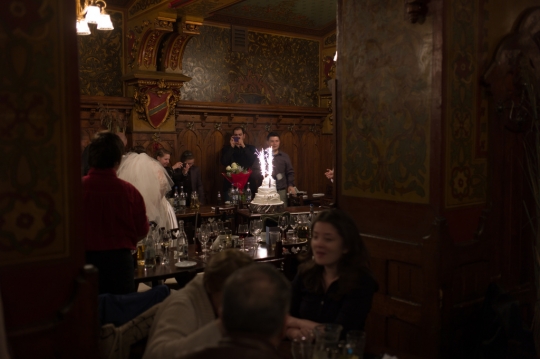
A local wedding amidst the tourists that fill Caru' cu Bere to the rafters
According to locals, the original dream of the reinvigoration of this neighborhood was to create an artists’ quarter. Although the current iteration is more gentrified than this—and it’s no Postdamer Platz, so this gentrification is very relative—gems like the small bar Atelier Mecanic shine through. It’s a sort of high style junkyard where the local cool kids drink amidst a setting various mechanical trinkets repurposed as thoughtful decoration. The communist-era leftovers lining the walls are strong material symbols and it’s tempting to see them as trophies of the conquest, now drained of their robotic animation and relegated to watch from their perch on the walls as contemporary Bucharest thrives. It’s the kind of place where one imagines a new generation of intelligentsia congregating, like the editorial staff of Decat o Revista, an upcoming local magazine on the model of “Wired meets the New Yorker”, or the group of architecture students sketching across a narrow table while I visited.

Sunday afternoon in Atelier Mecanic
But one does not come to Romania without thinking about Dracula, and so to his castle we go. Three hours north of Bucharest is the town of Bran, the population of which has just grown by 80 for Connection, a long weekend focused on building social innovation capacity within central eastern Europe. Initiated by the enthusiastic four-person core of Ropot and executed with a network of partners, the event brings together a wide range of people from Romania and neighboring countries to bring new ideas to the conversation. Carefully crafted as a multi-day event, it’s also designed to build connections and spread knowledge laterally.
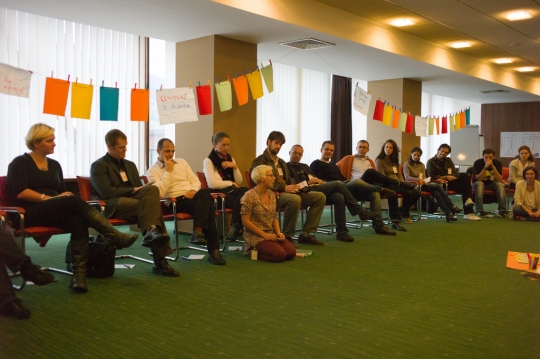
Don't let the looks fool you, although the atmosphere was decidedly relaxed, Connection was carefully orchestrated

Blindly-drawn portraits posted as a who's-who of the event
In the spirit of the many social entrepreneurs in attendance, I came to make a simple pitch: details make or break big picture ambition, and design approaches are a useful lens to pursue the details and the big picture concurrently. Under this umbrella I took the opportunity to share Sitra’s work on projects including HDL, Synergize Finland, and Low2No. The latter containing an excellent example of the big picture/small detail balance in Sitra’s efforts to remove barriers to large scale timber construction in Finland. This is driven by the big picture goal of a carbon neutral built environment but involves to specific (but unexpected) actions such as working to change fire codes so that large scale timber construction is possible, not just for us but for others as well.
But I started my talk with a simple observation from the streets of Lipscani: we live in a world of multiple overlapping systems and yet these are all too often sub-optimized in isolation of each other. In just about any European city you can observe this for yourself in very concrete terms by paying attention to the downspouts. Often you will find that downspouts and other external plumbing takes a less than direct path to the ground, and occasionally one that involves significant conflict, such as the photo above with a drain violently puncturing through the decorative plaster work of the building. This is a visible symptom of the architect and plumber not agreeing on which system will take precedence and which will gracefully defer.
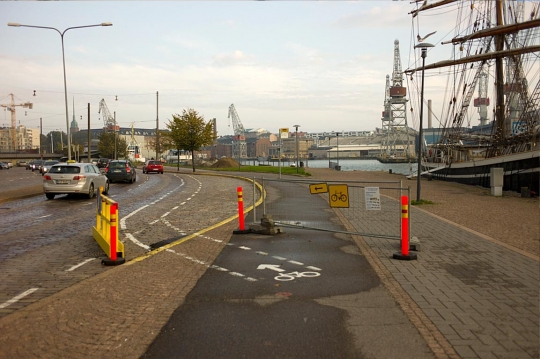
The rigidity of different systems becomes extremely apparent in moments of forced intersection
It’s an example of the impossibility of agreeing to disagree when decisions are involved. We can agree to disagree on a philosophical basis because this stays in our minds, but when it comes time to do something in a world of finite space, time, and material, action requires agreement—or violence.

Function piercing decoration, or: the hard considerations of gravity, flow rates of water within a pipe, and the threat of water damage against the soft factors of the cultural value architectural form, symbolic meaning of a building, and connotations that a physical structure conveys onto the organization that sits within it
At the core of this observation, and my pitch that design is positioned as a lens to help us make sense of it as a practice, is the observation that we’re still often clumsy in bringing synthesis to hard and soft factors. In the example above, rain water, flow rates, gravity, etc. vs. architectural form, cultural meaning, social connotations.
To resolve these two into a harmonious whole, as one is able to observe in more considered acts of architecture, requires a synthetic approach that balances the demands of hard and soft factors. This is something that the best businesses do as well. Nokia had touch screen phones much before Apple, after all, but the technocratic approach they took to conceptualizing a phone as a gadget inhibited full consideration of the softer side of the cultural role of a cellular phone. (For what it’s worth, this is demonstrably different now that Nokia Design is under the leadership of Marko Ahtisaari).
And so one of the central aspects of the conversation at Connection was the difficulty of bringing hard economic costs and soft social benefits onto the same ledger so that an attractive investment case can be made to appropriate investors. As groups across Europe are currently struggling with this issue, I was not surprised to see the same here in Romania. What encouraged me, however, was the verve with which some of the attendees took up the challenge.
As groups which aspire to support and enhance local communities increasingly look to social investment rather than grants, an important bit of mindset change is occurring. The more we as a society are able to entertain social returns on investment the closer we are to obtaining one of the basic mechanisms of a healthy social society—one that neither forces each individual to be a self-sufficient island nor forces the state to make unrealistic promises.
Investments come with investors, and investors have a moral obligation to put their money to best use. In the past this has more often than not implied the best annual return in financial terms. Looking forward, the notion of returns will slowly become more open, perhaps also including social returns expressed in monetary equivalent in a manner similar the cap and trade of carbon emissions.
The reason why I gave up my weekend to participate in an event in the middle of Romania is because I wanted to see how this part of the world was thinking through these issues, and what I might be able to bring back with me to our work in Finland. There are a handful of leads I will be following up, but the thing that came through most clearly was the drive and commitment of the participants to devise new ways of addressing the issues they’re concerned about—be it corruption, poverty, social exclusion—with a constructive eye towards the future. Connection itself is a testament to that by virtue of the fact that it eschews the typical conference format of individual grandstanding and hands-off consumption of presentations and instead delivers a weekend of capacity building.
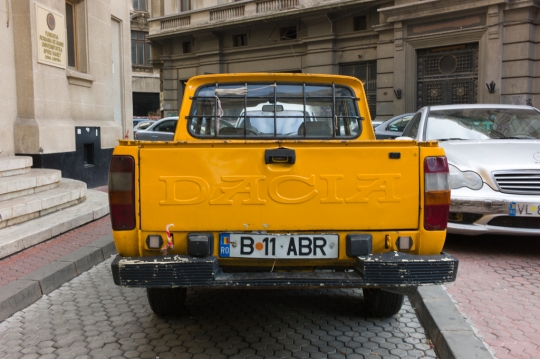
Romania's native carmaker, Dacia
We took turns sharing experiences in finding the right product, developing a business case, and what to look for in policy EU developments that will affect social innovation. But also about very pragmatic skills and tools such as learning how to hone a pitch and how to skillfully use media—both traditional and non. These how-tos were anchored by a mix of stories on the ground from individuals such as Chris Worman who is developing an innovative community ‘loyalty card’ scheme in central Romania and Dr. Anna Burtea who is exploring new commercial opportunities to enhance her foundation’s reach and impact. As examples of social innovation in development they were not all easy-breezy success, and that’s what I appreciated most. The Connection team managed to create an environment where frustration and failures were just as much a part of the conversation as success and scale.
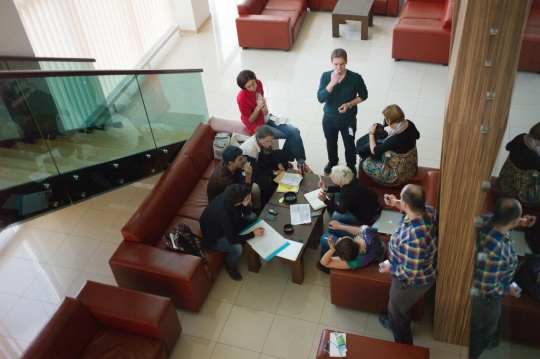
Ropot and their co-organizers take a moment to regroup and adjust plans for the next session
So when I write that I left the event feeling optimistic it’s for the same reasons that I enjoyed my brief time traveling the landscape of Romania: it’s a place that is still in the habit of making things, but equally one that can remake and repair when needed. Perhaps because of the relatively high levels of contrast visible even on the street—I did, I must confess, nearly escape a pack of angry wild dogs—I detected in my fellow attendees both a shared sense of responsibility for the future as well as an imperative to find one’s own specific contribution.
Back in Bucharest, as I type this blog post I am using a wifi network with the password “2030wifi”. An eye on the future, indeed.
It's happening again. The timeline between the end of week and our weeknote going live is slipping. This is mostly due to the fact that we're at a wonderful moment in the year: budgeting. At Sitra we're crossing our tees and dotting our eyes on the plans for next year, playing out scenarios at different investment levels, and having a conversation about how to best manage the portfolio of projects.
In light of the above-mentioned focus soaking up a lot of our attention, a random sampling of Things We Looked At.

Still from Social Life of Small Urban Places, a film by William H. Whyte. More on this below...
Today we're flattered to see our efforts highlighted in a piece in today's edition of the UK's Guardian. The essay by Justin McGuirk does a great job of explaining how we approach situations which are often difficult to make sense of, let alone gain traction on. Justin's explanation of the way that specific, tangible entry points allows for new forms of consensus is a refreshing read. We are often struggling to put these notions into clear words, so it's nice when someone else does your job for you.
A trickle of feedback is coming in from the book. Thank you to everyone who has taken the time to share your thoughts with us already. We've taken to saving these emails to a folder and in some cases printing them out and dropping them in the impact box, a tattered cardboard container filled with tokens that help us trace the impact of our work.
It feels a bit funny to revert to such a low tech solution, but the palpable sense of accumulation is a nice psychological side effect. One of the things we're trying to be better about is understanding the feedback and responding to it as we shape future plans. So by all means, if you're keen to give us feedback on how you see HDL as useful to your work, or how it might be more useful, we're all ears.
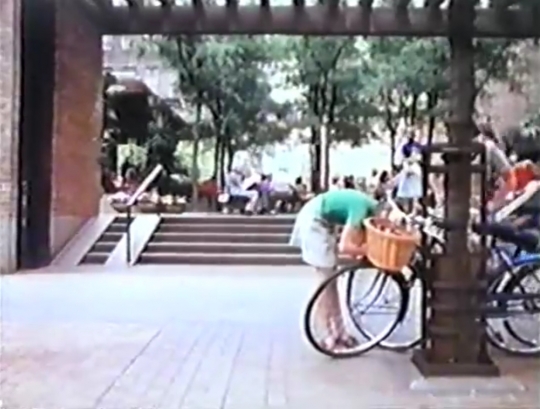
Another still from Social Life of Small Urban Places, a film by William H. Whyte
Speaking of books, I will be in Romania this week delivering a keynote and a workshop at the Connection 2011 conference. I'll have a couple copies of the book with me so if you're interested in having one, just ask.
Film break! Careful... you're in for a full hour.
How excellent is that? Dan and I have been digging through some archival materials (including the Social Life of Small Urban Spaces) as we explore the notion of "legible practice." What does it mean to carry out a body of work and to self-consciously do so in a way that makes it easier for others to follow or to join in?
In some sense this has been a discourse about what it means to be "open" but we've gravitated more towards the word "legible" because it speaks to the difference between just doing something where people can observe, and doing in a way that opens up and documents the tacit decisions for others to understand.
William Whyte's work checks the usual boxes of sitting at the intersection of design and social sciences, but what inspires us is the blunt, thorough approach to observation as an evidence base for design principles. The video is still refreshing from the vantage point of these 23 years on. It's this kind of spirit that we are subtlely trying to bring to our work (and yours?) through tools like the Design Ethnography fieldguide.
If you're into this kind of design practice, I highly recommend that you take a look at the Young Foundation's Head of Design job posting. It's a good post at a great outfit but applications close this week.
Finally, I'm happy to have the opportunity to point to work by Seungho Lee, our superstar intern from last year, who is doing great stuff through the venue of his company About:Blank which makes excellent products with local craftspeople here in Finland. This video is about one of About:Blank's chairs, a humble process that nevertheless is pursued with an excruciating level of detail and care. Congratulations to Seungho & team.
One more thing. It's fall time here and the many courtyards of Helsinki are, for these few weeks, some of the best kept secrets of Europe.
The air is increasingly crisp as autumn falls upon Helsinki. And yet summer is not giving up without a fight. This week we enjoyed one of the warmest September days on record. It does feel warmer than last year about this time.
We have been taking advantage of the weather by getting in a few last exploratory walks for lunch or mid-day coffee. As winter sets in the radius of lunchtime possibility closes down and the daily rituals change. We try to take as much advantage of the warm months as possible, often working in cafes, libraries, or other nooks around the city for half the day or so. As it cools off we'll be spending more time in the mothership.
Beyond the niceties of a good lunch, food has been a focus lately because of a bit of work we're doing. Street food, in particular, though we're taking a rather wide interpretation of the term. More on this soon, as we are preparing a slim publication on the topic. But the gist is that we're interested in how food cuts right to the nexus of so many interlocking systems. While it is deeply cultural, ephemeral, and literally a mater of taste, food is also an essential current in the hard flows of economics, health, and logistics.
As we pursue ways to positively affect the systems that shape daily life, we are searcing for entry points. The essentialness of food makes it a great candidate to act as a tangible pivot or hinge which allows us to research, observe, and design simultaneously at a very minute level where execution is direct and feedback loops are quick, as well as more abstract and systemic levels which on their own lack immediate feedback. More on this as it develops.
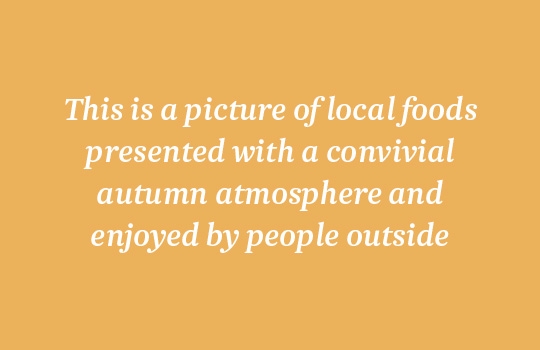
And it used to be a real picture of the Fiskars Slow Food festival held this weekend. That was until my camera decided to reformat its memory card.
University of Helsinki have recently published a video. It features a herring and it is a nice video.
From food to space. The other topic on high rotation within the team is community decision making. How do we make decisions together? And more specifically, how do we make decisions when it's not possible to agree to disagree, such as when there's a chunk of the city involved. A park, a disused lot, a nice corner, a store front. That kind of thing.

Borrowing from Nolli and thinking about more rigorously pursuing his technique of mapping the public realm.
Although this is a very nascent topic for us as yet, we've been doing some sketching. This one in particular is a quick study of the 'hidden' courtyards of Helsinki. Although the city is full of wonderful interior courtyards, they're mostly out of sight and really quite out of mind. How could these spaces become more of an asset to the city?
Both of these projects are orbiting around ideas that we explored with Clues to Open Hesinki, a pack of 'postcards from the future' that we created with the help of OK Do last spring. And while both the food and the courtyards have come back onto the radar through their own paths, it is interesting to reflect on the fact that they were also amongst the dominant themes of the conversations we had when developing Clues. I suppose I should say that it's gratifying, actually. The small bet we made with that project is now repaying its dividends and proving to be useful preliminary research for two projects which have their own focus at a new scale of ambition.
A small note about the book: I've updated the page to include information about where to find it in book stores. Currently there are only two, but I'm hoping to have time to work on expanding this list a bit. If you have suggestions for appropriate shops in your neck of the woods please leave a comment here.
Other projects: Justin continues to tweak the Low2No website, which is overflowing with details about the project; Marco had some promising meetings relating to the exchange, as well as work related to World Design Capital; Dan has been wrapping up some essential elements of groundwork for the smart systems aspects of Low2No as well as writing about food; I was out half the week on a mini-break and then handling the technical bits of the Low2No site; and Johanna is handling logistics and administration steady as ever.
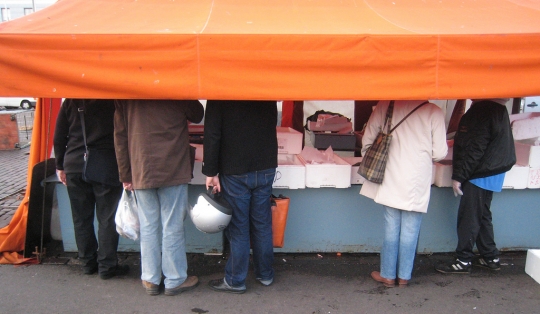
Justin enjoyed the Herring Fair three years ago.
To close this weeknote I'll leave you with a link to MindLab's wrap up summary of their How Public Design? event that Marco and I enjoyed last month. Have a look—we'll be doing the same, perhaps after a visit to the Helsinki Baltic Herring Fair.
When the calendar looks like this you know it's going to be a steamroller of a week.
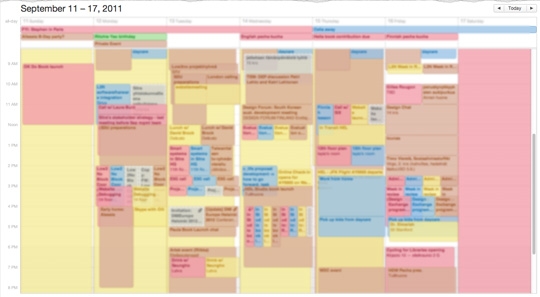
Names blurred to protect the innocent
The easiest place to begin is with the book that we mentioned last time. One week on from launch and we've had a modest bit of attention on that. So far a lot of encouraging feedback, so we are happy to hear that it is finding its way usefully into peoples' lives.
On Wednesday we held a launch event here in Helsinki to discuss some of the broader innovation challenges that the Studio Model was designed to tackle. And of course to give away copies of the book. We were humbled by the fact that About 60 people showed up on a rainy and blustery afternoon. Kiitos, kaikki!
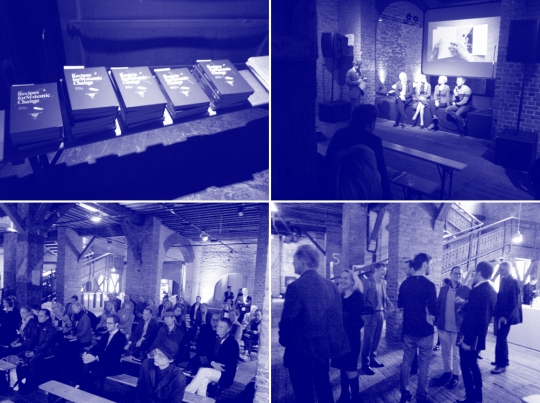
Colors changed to hide the fact that these were low resolution pics taken on a camera phone
On that note, if you're in London we will be in town this week for some meetings and are taking advantage of the opportunity to have a book launch there as well. See the Facebook page for details and please RSVP (soon!) if you would like to come.
As I was cleaning my desk I came across some sketches done in preparation for the book trailer video. We stayed pretty true to these thumbnails. Not bad for ideas drawn on a sick bag.
Enough with this book thing. Things continue apace on other endeavors. This includes work in-house that Dan and I are doing with our colleagues Olli and Tapio to prototype some of the working environments and habits we anticipate fostering in the eventual new offices which are part of Low2No. More on this soon.
It also means Justin, and to a lesser extent myself, spending late nights working on the new Low2No website which we will be soft launching soon. It should look familiar to readers of this blog.
Because three's a charm, another piece of great news came in for Low2No this week. The project has received an Acknowledgement Prize from the Holcim Foundation. Thanks to our partners at Arup, Sauerbruch Hutton, and Experientia are due as well for this.
Thursday morning while Marco was in Estonia presenting at the Nordic Council of Minister's Modern Eco-Cities conference, the rest of the team had breakfast with Joi Ito and Markko Ahtisaari.
Markko kindly invited us along to hear Joi give a talk at Nokia. Joi deftly connected many dots and it was a true pleasure to hear him talk about his plans for the MIT Media Lab, which he now directs. I'll keep this brief because the thoughts deserve a more careful bit of writing, but if there's one thing I took away from Joi's presentation it was this:
Because of the declining cost of doing things and increasing levels of complexity in the systems around us, it's often cheaper to prototype (and recover from potential failures) than it is to assess risk.
Update: Joi has posted about this on his website.
This dovetails nicely with some slow burn research we've been doing into what you might call 'cultures of decsion making.' Ultimately the ways in which we perceive, assess, and mitigate risk shape so much of what we allow ourselves to do. Likewise, the manner in which we anticipate, plan for, and recover from failure defines the outer limits of what we allow ourselves to reach for.
When we look at the rise of the open source software movement, agile project management, and the popularity of design these things add up to a new culture of decision making. The better we can coherently articulate the value of these approaches as ways to cope with the GFC and other black swans, the more likely we are to find a way through.
Or at least that's the hypothesis we're prototyping.
Perhaps the last thing we expected to do Thursday was end the day by moving 742 kilograms of paper, cardboard, and ink around Sitra HQ. But when a shipment arrives and the palette it sits on does not fit into the elevator, this is what happens. In other words, the book that we've been mentioning on this blog is finally here! Thanks to the helping hands of Seppo, who makes this building tick through his steady management of the front desk, we were able to get everything in from the loading dock in no time.
Inside were lots of these:
In Studio: Recipes for Systemic Change is a book about crafting vision. It's about how to take something big, messy, and complex and very rapidly begin developing a way to respond to the problem. It gives an introduction to the what and why of strategic design, documents the studios that we hosted last year, and then offers a practical "how-to" manual for hosting your own studio. Hop over to the book page and watch the trailer video.
Marco, Justin, and I are really honored to have a Foreword from Geoff Mulgan of NESTA and an Afterword by our very own Mikko Kosonen. These contributions put the work of Sitra's strategic design unit into the wider context of Sitra's activities as a whole, as well as the social innovation more broadly.
We have some launch events coming up and are looking forward to these as opportunities to meet old friends and hopefully also some new ones. If you've been following the blog or interested in Sitra's strategic design work it would be great to meet you. Please join us for one of the events in Helsinki or London.
Putting the book together has been an excellent—if sometimes grueling—opportunity to revisit the ways that we talk about our work. But it's also amazing the number of decisions put into motion by something seemingly as simple as "let's write a book". What began with documenting our work in a format that is easy to share, grew into a mess of micro projects that looks something like this:
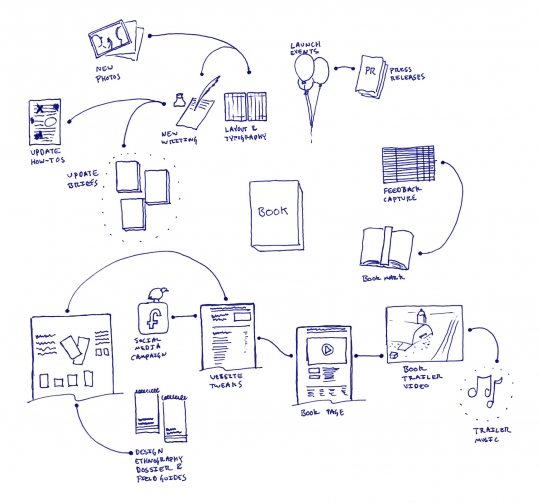
Sometimes a simple book is not so simple.
TwoPoints have done a stellar job with the physical object; we've tried our best to create a PDF that is as easy as possible to use (for instance, it has a hyperlinked table of contents); and Sitra Communications team have been doing bang-up job helping with the press stuff. Well done, everyone.
More pictures. Or in other words, this is where we fulfill Justin's dream of being a hand model.
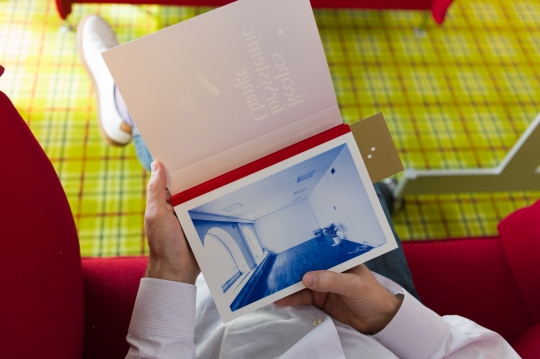
There's a cloth binding hiding inside.
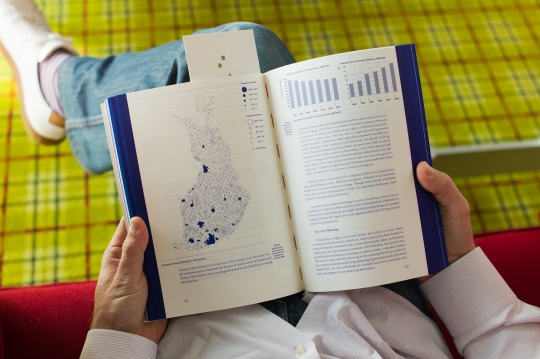
All three Challenge Briefings from last year's studios have been refined and included here.
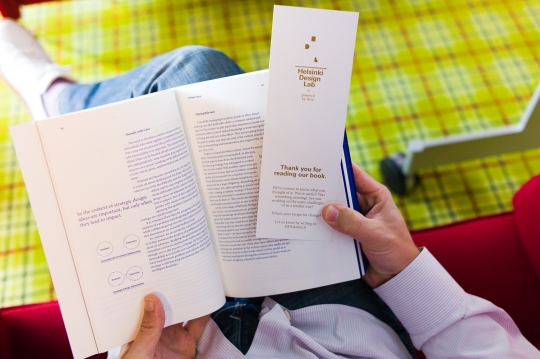
The bookmark is a thinly veiled attempt to solicit feedback.
To highlight some of the ancillary things we've been lining up before the book launch, there's a new dossier on design ethnography. This includes a "fieldguide" available in English and Finnish. It comes out of the Synergize Finland studios that we hosted earlier this year. We've also been adjusting this website to link up with Facebook, for instance, and to be more suitable for reading on an iPad and other tablet devices.
Onwards, onwards. If you're here in Helsinki enjoy Design Week and perhaps we'll see you around town.
Lots of little things, these last weeks. Perhaps this is appropriate since some of the trees around town are already starting to let go of their leaves. Increasingly, there are lots of little things all over the ground.
Justin and I have been doing a bit of work on a new website for Low2No, but it's mostly him down in the mine at the moment. I'm pitching in with advice here and there as we navigate that towards launch in early September.
Marco and Justin have been looking after the Low2No block itself, as they do in some form or another just about every single day. Justin was in Berlin meeting with our architects, Sauerbruch & Hutton, on the design of Sitra's new offices. Meanwhile Dan and I have been working in-house on the continued development at the intersection of Sitra's offices and the cultural aspects that this change will open up. In the process we've been making lots of lists, often involving spectrums or continuums, that try to articulate the qualities we're looking for in the new offices. Boxes, be gone.
We shared a brief but good discussion with the Elinvoima team trying to help them narrow in on a fertile topic for the next round of the forum. It was a discussion that spanned from the invention of democracy to the national anthem of the Czech Republic and the rhino-shaped capital of South Sudan. Marco was with them again for a longer planning session.
True fact: the team was in Lahti for half a day and the train ride back (and subsequent lunch) were some of the most productive hours of the entire week. During which time we revisited the conversations Dan mentioned last time and got one step closer to An Answer. I suspect it surprised all of us how quickly a disjointed set of possibilites seemed to lock into place just at the end of lunch. Undoubtedly this will have jostled itself loose again by next week, but as long as things come together for a moment of clarity on a regular basis we're on the right track.
Otherwise: more book related odds and ends, a visit from Sanna and her three month old baby boy, sorting out our need for interns (get those portfolios ready), a braindump from the legal team, and some hurried videography shooting ghostly clouds dropping rain. Lots of little things.
We're still technically on holiday here until next week, but things are coming along with our book project so I thought I would share some pics from the process of bringing something to press.
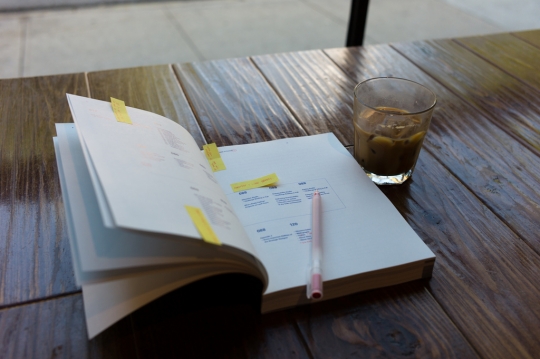
An early dummy. We used this to mark up all errors and changes.
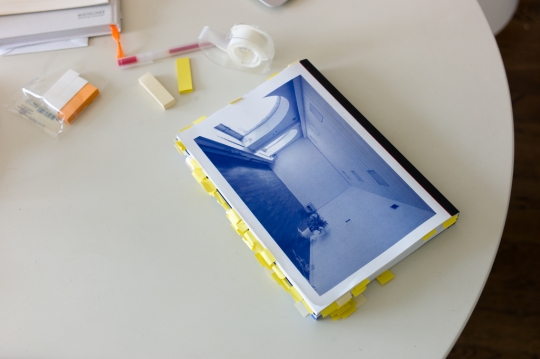
This is just after marking all of the changes and updates. There were a lot of things to fix.
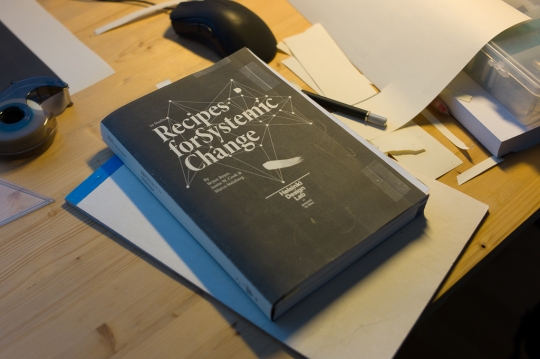
Mocking up the cover on a dummy book.
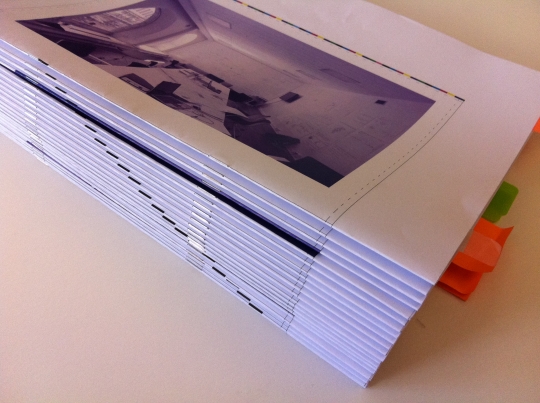
Plotters from the press. Testing ink distribution and other technical elements. Spotted a couple more issues to be resolved too.
Back next week with a real weeknote!
It's July so most of us are on vacation (along with the rest of Finland). Unfortunately publishing deadlines do not go on holiday, so we are still clocking in to work on the book. Getting there.
Well, that's something.
We did start the week with that conference call Dan mentioned, and it was good, but otherwise pretty quite around these parts. Justin and Dan are on holiday. I'm on partial holiday. And Marco has been out of the office at the Tällberg Forum.
Recommendation: Enjoy summer. Weeknotes will be thin now till August.
With Juhannus now days away, we're transitioning from a spring of spiky activity that came in high and rapid peaks to a mid-year that is more even-keeled. As Dan mentioned last time, this includes experiments in our collective workflow, such as new rituals involving the whiteboard.
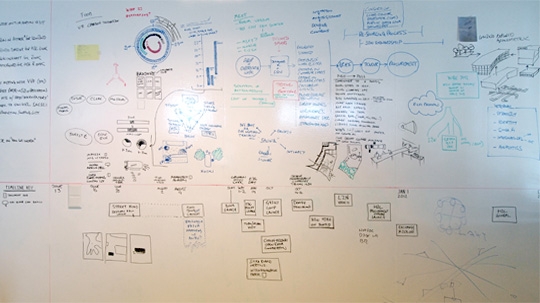
One week's worth of thoughts, notes, conversations, ideas, and misfires.
A couple balls rolling at the moment, all in different directions and each with their own pace. Marco, Justin, and Dan are each deep in their own corners of Low2No and I've been pitching in a bit here and there; our peek into the culture of street food in Finland continues; and we've been reflecting on and documenting our experiences as a cross-functional unit within Sitra. This last bit is part of a larger transition that is happening within our organization. So in addition to a lot of time spent at the board, we're also regularly whipping up one-pagers and trying to distill our experiences into easily digestible documents. As frustrating as it may be to constrain oneself to a single page, the discipline of brevity is a good and worthy challenge.

Draft book spreads. These are only a few days old and yet already things look much different.
And then there's the book. Now that we've organized and hosted a total of seven studies, our knowledge about how to do this sort of work is stabilizing. With interest about the Studio Model from Belgium to Brazil we decided that a 'recipe book' would be a good format to share some of our experiences (and hopefully insights)—so that's exactly that we're doing. After spending winter and spring writing, we're now in production. Editing, layouts, images, diagrams, and more. Martin at TwoPoints has been peppering us with questions about bindings and other arcana of bookmaking, which usually send us off into a small spiral of consideration before we come back with a decent answer. As these aspects calm down we are starting to think about electronic publishing. There is, quite frankly, a lot to do. So far it has been a relatively painless process. So far.
If you missed it, earlier this week we posted a slew of photos from the studios that we organized last month. Ivo shot in color this time so they look different. Last year was gritty chiaroscuro, but this year the images have an otherworldly lightness.
Over in Denmark, our friends at INDEX send word that they've posted the finalists for the 2011 INDEX: Prize. Congratulations to all of them—and good luck on the final round of competition.
And now that we have a healthy history of weeknotes we can do neat things like this: This was week 117, one year ago we were in Week 065. Moi Moi!
As we mentioned previously, last month we were working with the Synergize Finland team to run three concurrent studios on the theme of "new work". The details are continually pouring onto the Synergize (Elinvoima) website, so you can hop over there for the updates as the programme continues, but here's a peek at the week in an abreviated form.
Monday
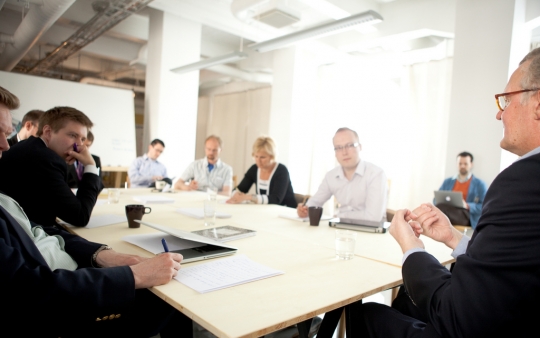
Esko Kilpi talks with the 'new knowledge work' studio team about the ways that social media and the internet are changing working relationships. Monday was full of talks with guest speakers.
Tuesday
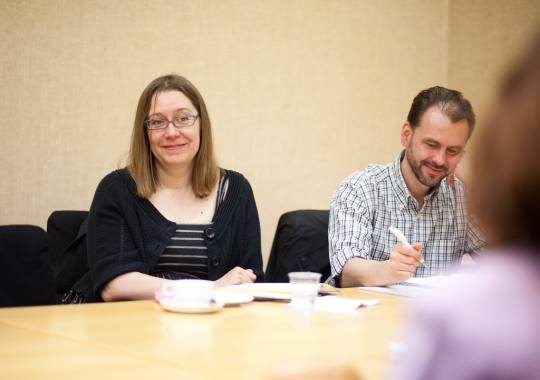
Tuesday each of the three studios were out and about all over Helsinki, making site visits to see the realities of contemporary work in each of the three themes. This is a scene from the group who visited the City of Helsinki offices to talk about immigration and work.
Wednesday

With a bit of top-down and bottom-up perspective percolating from the first two days, Wednesday is when things really got down to business. The teams were in studio all day beginning to synthesize their insights and ideas through group discussion...
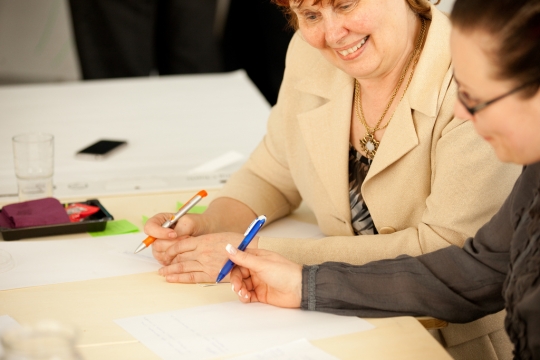
... and collaboration in pairs.
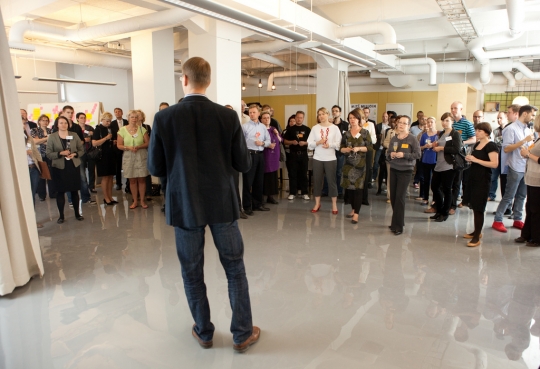
That evening we had a town hall meeting with 60 guests where each of the three studios gave a 4 minute 'elevator pitch' of their current thinking.
Thursday
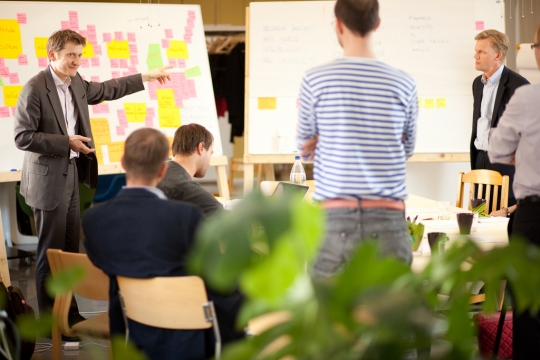
Marco and the rest of our Strategic Design Unit were continually 'sparring' with the studios to help them hone their proposals.
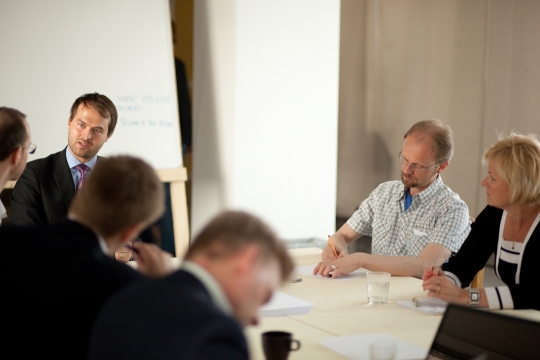
As the end of thursday came near, the deadline began to loom large. We ended each day with a dry run—'what if you had to present now?'
Friday

Dan and I stayed late on thursday night to help the teams wrap up their presentations. No one used Powerpoint, so there was a lot of paper-wrangling come friday morning.

The three teams presented one after another, each giving their version of the big picture and sharing a collection of 10 action areas each described in sketch form, both verbally and visually.
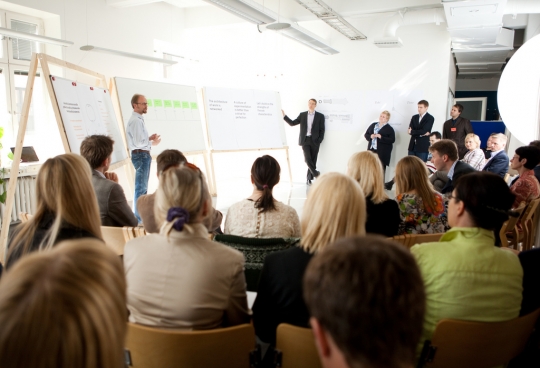
Amongst the audience were five special guests to give focused feedback: Annika Forsander, Kirsi Juva, Mikko Kosonen, Risto Siilasmaa, and Anni Sinnemäki.
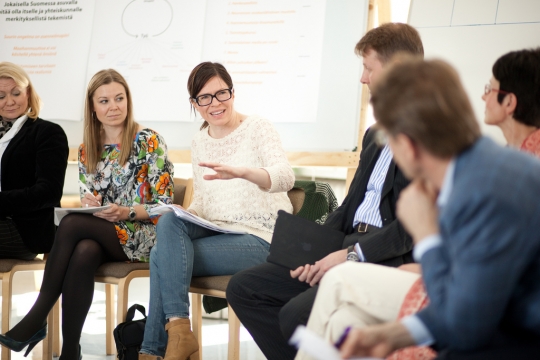
Anni Sinnemäki responding to a question by Mikko Kosonen.

After the presentations concluded we moved all of the chairs out of the way and set up a big table to continue the discussion during a casual lunch.
Next Steps
After the studio week the teams have had a subsequent session to begin developing some of the action areas into social innovation projects. The trajectory of that work is based on the rapid development of a big picture 'architecture of solutions' in studio and will culminate this fall when Sitra hosts everyone again for a celebration and announcement of the projects that are continuing forward.
As for us, we learned a lot from the week and it was an especially useful experience to run multiple studios concurrently. Exhausting, to be sure, but useful.
By nature of being an internal collaboration within Sitra we also dedicated time to articulating in a more careful way how to put something like an HDL studio together. Part of this was iterating and formalizing the tools and techniques that make each of the days tick.
One example is an 'ethnography field guide' that we developed with the help of WeVolve for the fieldwork on tuesday. On my plate is to finish up the English translation and get that document up here as a download, which will happen before summer kicks in.
In the meantime, there are many more photos of the week on our Flickr account. Enjoy!
All photos by Ivo Corda.
As June begins we've been working on a number of small bits: helping some of them grow into slightly less-small bits, and eventually real projects. In other words, sketching, discussing, calendaring, prioritizing.
On Thursday we had the luxury of spending an entire day to look at only two issues. That much time dedicated to such a limited agenda is nice and by the end of the day we were all exhausted.
What else? Some quick hits:
Dan was at Aalto University to give a presentation in the Pragmatic Utopias seminar
We at Sitra launched a new website in beta form. This has been a long time coming and we're excited to have it as a more fluid way to share our work. You can read about strategic design in English and in Finnish (and more content will be available in English in the fall).
HDL can now be found on Tumblr, where we are blogging things that look interesting and related to strategic design. If this experiment works out we will figure out a way to bring some of that content onto this site as well, but for now it's in a separate sandbox at helsinkidesignlab.tumblr.com.
So let's face it, if you're reading this site and you just thought about clicking that link for the Tumblr blog, then perhaps it's time that we make our friendship official. Luckily, Facebook is here to help us Become Friends. In other words: HDL can now also be found on Facebook, where you can can give us a thumbs up if you're inclined. Or generally follow along with what we're doing.
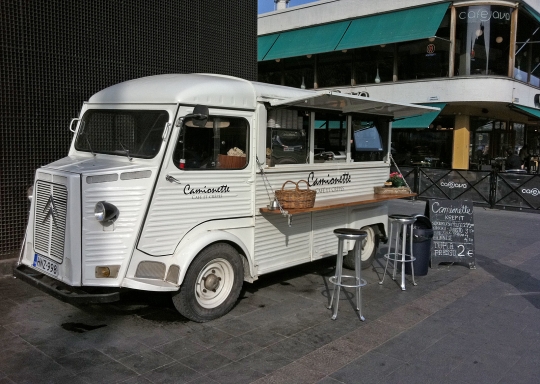
Being open 24/7 gives the operators of Camionette a valuable perspective on the affect of their offering on the street culture around their truck. Hint: It's much different at night.
And finally, the Strategic Design Unit has been talking a lot about street culture, and in particular the way that food helps set the tone of the street. This was aided by a visit to Camionette, Helsinki's first food truck. Tasty.
With the sun glinting off the Baltic and a cloudless sky stretching to the horizon, this weeknote commemorates the beginning of summer in Helsinki. Amazing.
As much as the weather may entice us to spend the afternoons biking around town in search of the perfect corner of park, we've been busy... as we usually are just before summer.
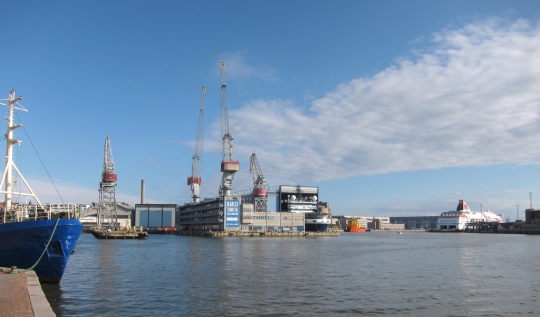
Busy day in the harbor between Hernesaari and Jätkäsaari.
Chrtistian Bason and his team from MindLab stopped by for a visit and a chat about the realities of practicing design within public sector organizations. We've been inspired by MindLab's excellent work in service design for the Ministries of Economic and Business Affairs, Taxation and Employment in Denmark. They're one of the true success stories of public sector design and as we continue our work in Finland we are looking at how to learn from MindLab while folding strategic and systemic opportunities into the mix.
We've also been reviewing and de-briefing after a very busy week with the three concurrent studios that Dan mentioned in his last post. As always, the studios were a great learning experience for us too—as the participants push and pull the boundaries of the studio 'model' we learn where the critical points are.
Riku Siivonen, a journalist who has been working with Sitra on the Synergize Finland programme, prepared a video of the week embedded below. It's in Finnish, but even if you can't understand the words you can get the gist of how things went.
At about 5:25 into the video you will find the beginning of day 5, which is the 'final review' of the studio work. One thing is conspicuously absent as the studio teams present their work: any kind of digital screen or projection.
As we sparred with the teams throughout the week we pushed them to visualize their ideas with the tools at hand. Especially as we all began to think about the final presentation from a goal oriented point of view: the idea is to conclude the studio with a conversation about the systemic understanding of the problem and a collection of action areas that the studio teams have identified as important opportunities.
It's difficult to have a strong conversation about a system when it's presented in a linear presentation (such as Powerpoint slides). What often happens is that the last thing on the screen gets a disproportionate amount of focus or there's an awkward shuffle back and forth through the slides as conversation moves from topic to topic in a nonlinear fashion. For this reason we pushed each of the teams to think about the strategic objective of the conversation and to use the walls around them—aided by giant prints—to create an environment for rich conversation that would help foster and develop their ideas.
Having the contents of the presentation on the wall enables the invited guests and the entire audience to walk themselves back through the whole collection of ideas and important points in their own order and at their own pace. Ultimately this helps the final review be more of a conversation and less of a presentation followed by response.
With encouragement (and a tiny bit of arm-twisting) each of the three teams to relied on the strength of their presentations and their public speaking skills to begin the conversation without the aid of a digital screen. This worked great and no one seemed to complain that they were without the PPT-prosthesis!
All in all it was a great week.
If I had a time machine and I could change one thing I would hop back to the beginning of last week and remove all of the post-it notes from the studio space (you'll see tons in the video). The reason for this is simple: post-it notes trick people into being lazy.
Let me explain. The way that post-it notes are commonly used in workshop settings is to capture an idea on a portable piece of paper. This paper can then be moved around at will and eventually accumulated on a bigger piece of paper and then rolled up and put into the closet and kept forever. Ideas captured. Success?
Post-it notes record ideas and allow them to be easily migrated and reorganized, but it's not a good medium for mutating and synthesizing ideas.
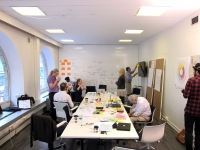
Evidence that we're not allergic to posti-it notes, just that we like their use to be a deliberate choice and not a coincidence of least resistance. This is from the HDL Ageing Studio last summer.
One of the reasons that we prefer large sheets of paper or whiteboards is that they encourage collaborative mutation. If you realize that something is drawn in the wrong place, it must be erased and re-drawn or somehow altered to meet the new intent. By drawing and redrawing, writing and rewriting, opportunities to adjust the content and format—to literally re-present the ideas—continually emerge.
When shuffling post-it notes these opportunites are lost.
Choices about how thoughts are committed to paper and in what format are the visual equivalent of tone of voice. Think about the dramatic differences in interpretation between a statement vocalized in an earnest tone of voice or a sacrastic one. The differences in perception are huge!

Collaborative writing session during the HDL Studio on Education (2010). Photo: Ivo Corda
By literally re-writing a statement one is able to revisit the choice of wording, its relationship to other content on the board, the scale, the color, and many other factors of the format which will inflect how it is perceived both by the author and by others... In effect, to change the tone of voice.
Even when sketching something quickly we obsess over the small details of how an idea is comitted to paper because it's in this process that a new level of richness emerges.
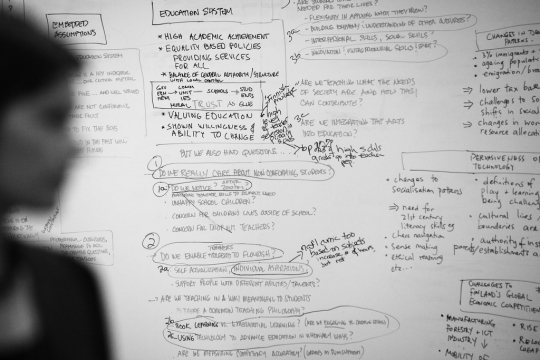
Scene from the HDL Studio on Education (2010). Photo: Ivo Corda
If a person holding a hammer is tempted to see all problems as a nail, what does it say about situations where the answer to everything seems to be a flimsy, sticky-backed square of paper? When doing new work it's sometimes important to test out new tools as well. Next time we'll hide the Powerpoint and post-it notes.
Nevertheless, congratulations to the Synergize Finland studio teams on a job well done (even with some post-its)!
Things reached a state of near-froth on Friday as everyone was zipping around taking care of last minute items for next week's three concurrent studios. Actually no, let me revise that statement after glancing at the clock: this week's three concurrent studios.
We will be located at the Hub Helsinki space all week. It's a wide open floor with plenty of room for three separate teams of 8-9 people. Or so we hope! Last week was the official opening of the Hub so we're helping them beta test the space.
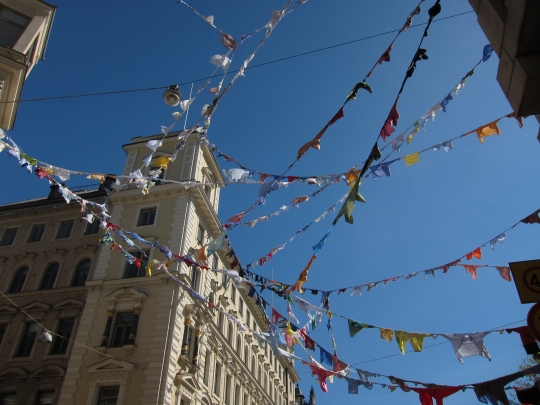
An art installation above Yrjönkatu
Otherwise things are huming along in the way that they do just before summer. Helsinki is finally starting to show signs of warmth and the snow is banished, with the exception of a few piles that are still lingering in shadowy corners.
Visits this week from WeVolve, who are helping us to produce a small 'field guide' for the studios to use next this week, and Sunkyung Han of the Hope Institute, who we had the pleasure to meet a couple years ago in Seoul. Meanwhile, as Justin and Marco have been hammering away on Low2No, I dropped by the Aalto University Department of Architecture for an end of semester critique with Tuomas Toivonen's students. There was some good thinking about how to design intergenerational spaces as well as Low2No-inspired ideas of transitional design.
We ended #111 with an all-hands meeting of Sitra's Strategic Design Unit, except this one was special because we have a new pair of hands! We'll close this weekntoe with a bit of suspense but you'll find out soon enough: #112 will be written by the newest member of our team.
This week was as pleasant as 110 is round. Progress on many fronts and no emergencies, though we do have a glimpse of a storm that might be rumbling our way.
Two weeks from today we will be wrapping up a round of three concurrent studios. With next week as the home stretch, we've been busy working with the Synergize Finland team to nail down all the details. This includes orchestrating field visits to various organizations as part of the Tuesday schedule, inviting guests for our 'final review' on Friday, as well as coaching the design leads and generally preparing everyone for what is likely to be a very busy week.
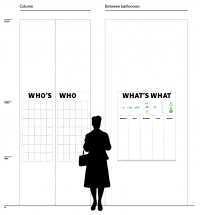
Drafting the infopanel for the studio. The calendar will be laminated so we can mark it up with a dry erase pen as things change on a daily basis.
This week we're also collecing all of the basics, such as schedule of the week and headshots of everyone who will be in the studio at various times, and making sure they get formatted and printed out as giant posters that will be located near the entrance to the studio. That's right, a poster is one of the tricks of the trade. But it's an important poster!
One of the things we learned from the three studios we ran last year (as well as one in Umeå this January) is that it's important to reduce cognitive overhead as much as possible for our participants. This includes making sure people have easy access the information that they need while they're with us for the week. Basically anything we can do to reduce anxiety is key, because that means peoples' minds are free to concentrate on the task at hand.
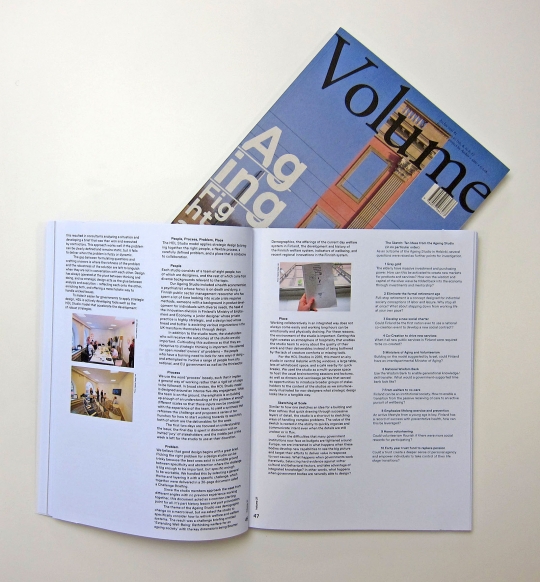
VOLUME #27:Ageing. Get your copy here.
We also got a nice surprise in the mail. VOLUME magazine sent us a couple copies of issue 27 which focuses on the theme of Ageing and features an essay by myself with contributions from Justin and Marco. The essay recaps the HDL Studioon ageing and delves into the potential of using the studio as a modelfor tackling similar issues in other contexts.
Although we've had opportunities to blab in interviews, we do not often have the chance to reflect on our own work in written form, so this was a (occasionally frustrating) treat. Thanks, VOLUME!
The issue is highly recommended and includes essays from Indy Johar, who was part of our studio, as well as Martti Kalliala who will be leading one of the studios in May and is also the person behind the New Architect's Atlas.
This was a week of incremental updates. Each of our ongoing projects moved forward in silence, so there's little visible progress that we can share in a meaningful way. When writing weeknotes these are frustrating weeks, but in reality they're important for pace-keeping.
A sizable chunk of Week 109 was spent preparing for, hosting, and processing meetings with various teams within Sitra. A week of meetings sounds like it might be dull, but we're starting to build a nice rhythym out of it. It's important work as we continue expanding the surface area between the Strategic Design Unit and the rest of Sitra. Most of these meetings revolve around refining the big picture ideas into an actionable plan, which includes stuff like spending the time to talk through seemingly obvious terms so that everyone in the room is on the same page. Sometimes we also invent and play games.
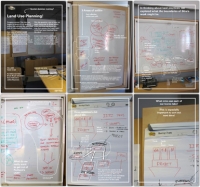
This is what our meeting notes look like. Sorry they're small, but they contain national secrets. (Not really).
Personally, my favorite part is wrapping up a session into a document that captures the essence of the ideas. We've been using something that we colloquially refer to as the augmented reality whiteboard. What this actually means is that we take pictures of the whiteboard and then draw in some lines and words on top of them in InDesign so that the bits which are in chicken scratch come through more clearly. It gets to be a nice challenge to see how much can be left to the marks on the whiteboard and how much needs to be added on top.
In other documentation news, Cynthia from the Young Foundation sends more pictures from the Global Innovation Academy in Bilbao that we talked about last time.
Aalto University School of Art and Design professor Tarja Nieminen visited with some of her graphic design students to talk about strategic design. They were especially interested to hear what its like to work at Sitra and within the government more broadly, and I was keen to hear how they think about their role as graphic designers in the context of upstream issues (like usability/legibility). We also geeked out on the way that type design has to contend with variable ink flow on different newprint paper stocks.
Somewhere in between meetings and visits, Marco revealed a shocking statistic: currently his mailbox includes 22,924 unread emails. He would like you to know that he's not proud of this fact (and most of them are from mailing lists).
Some vignettes from these two blurry weeks.
—
It's monday and Carl Mossfeldt of the Tallberg Foundation stops by for a chat at Sitra. Our two organizations have a region and a culture in common, not to mention a lot of overlap in our respective missions, so how can we work together? It starts—like many things—with a long lunch.
By coincidence, later that day Marco travels to Stockholm to share Sitra's work on strategic design with Members of the Swedish Parliament and the design community at an event organized by SVID.
—
Marco and I are in a conference room with Sitra's Energy and Landmarks programmes, spending a couple hours on a session to assess our combined activities that touch on land use issues in Finland. We're doing more and more of this lately. It doesn't feel like facilitation, but I suppose you could call it that. It feels more like being a portfolio manager of ideas. That was Wednesday.
—
Next day same thing, but this time with Sitra's Synergize Finland programme who we are assisting by organizing three studios next month. With about four weeks till the kick off there is a constant buzz of activity. We're revisiting the details that have been confimed for months to make sure they're still supporting the way the plans have evolved. "How much freedom do we have to adjust the space, did you say? Can we put a curtain here to add acoustic isolation?"
This is our first time opening up the operating model of the studio to people outside of our own small team, so it's a good learning experience. The most painful "whys" are the best ones and most important ones to answer—to make explicit. There are alot of "whys," especially around the role of the softer details.
—
Another Monday: I'm standing in front of 30 people in Bilbao explaining Sitra's use of strategic design as a way to match vision, which can be powerfully vague, with intent, which requires more focus and specificity so that it may guide action and decision. I was delighted to be presenting as part of the 'faculty' of the Young Foundation's Global Innovation Academy (GIA) inaugural programme. We also had a chance to do a quick iteration of the network mapping method that HDL initiated last year in our 2010 studios.

A snapshot from the event in Bilbao
The academy's goal is an important one. If I have to put it into simple words I would say that their challenge is to make social innovation the norm within the public and 3rd sectors. When that happens it will cease to be the buzz-enabled "social innovation" per se and become, more simply, the new definition of good public service. Best of luck to Andrea, Cynthia, Louise, Rob, and the team. We'll be following along!
—
Tuesday: an SMS arrives heralding a successful decision in the Helsinki City council with regards to bicycle lanes around Töölö bay. This came after a breif chat with Martti T. wherein he took it upon himself to visualize the issue using Sketchup, and in doing so change the nature of the debate. We hope to have Martti contribute a guest post on the decision in the near future. Until then we take it as a positive sign that even simple visualizations can have a transformative affect on decisions.
—
Friday. Finally Friday. It's all hands on deck for Sitra's Strategy team and we're huddled around the 14th floor conference room to learn some tips on design ethnography from Ville and Nuppu of WeVolve. This is one small part of the on-going changes at Sitra. It feels good. It feels like an exciting way to end week 108.
It feels a bit like an air traffic control tower in our corner of Sitra-house these days. Between various physical comings and goings, we've also been in the thick of routing projects to and fro.
A big item for us was getting the first 100% text draft of the HDL Studio publication out the door. It was a bit later than we had hoped, so it's nice to have relief from the pressure of being behind schedule. Now that we're receiving feedback from a couple people who have been enlisted to be critical readers it's starting to feel more real. Soon TwoPoints will be doing layouts and then it's truly off. Throttle up.
Marco has been spending his time between Low2No and exploratory meetings for a new (and yet to be named) project. Early feedback is positive but we're still awaiting clearance for take off.
Meanwhile we've been continuing our in-house collaborations as well. In the past month we have really begun to dig into what the Synergize Finland studios will look like. Stuff like securing the studio leads, nailing down key bits of the schedule, and also taking the time to revisit some of the core principles and renew our shared commitment to them. Boarding completed. Requesting clearance to push back from the gate.
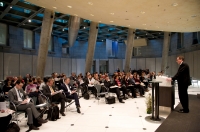
Opening of the SEE conference. Photo by Michael De Lausnay.
On Tuesday I was in Brussels to share Sitra's work with the guests of the SEE Project at their Policy, Innovation, and Design conference. I left the event feeling optimistic that the economic advantages of design+business, the so-called creative economy or ceative industries, is broadly appreciated. Design was also being used in multiple presentations as a way to bring the needs of users back into the center of decision making, particularly in the public sector.
It was nice to see the launch fo the Service Design Toolkit, for instance, because it gives tools to people who might already have the desire to work in a more empathetic way but are struggling to find a structured way to do so.
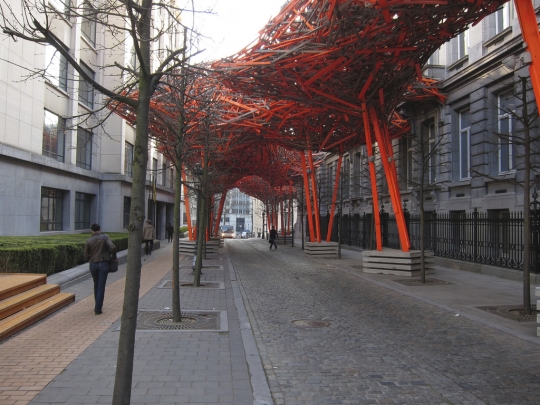
Outside the Flemish Parliament, venue of the SEE Project Final Conference: Policy, Innovation & Design
The mixed content of the event brought to the fore a point which seems unclear at times, particularly when "design" gets introduced to policy contexts. Does "design policy" focus on increasing the demand for design services in a "policy for (to support) design" sort of way? Or, on the other hand, does "design policy" refer to the use of design methods to deliver new or improved services, systems, or strategies?
The latter we think of as "policy by design" and that's squarely where we put our focus at Sitra through initiatives such as HDL. Both 'policy for design' and 'policy by design' have important roles to play, but being specific about which one is on the table at any given moment helps an audience to evaluate the value proposition of design. Thanks to Mark Vanderbeeken of Experientia for putting together a well-rounded lineup that succinctly crystalized these thoughts. Cleared for landing.
I suspect that our week ended the same way that yours did: in utter shock and dismay over the events in Japan. Between the floods in Australia and the ongoing crisis in Japan, the Pacifim Rim has already had a difficult 2011. It has been hard to do anything without checking the news regularly. Half a world away there's little we can do but hope for the best and give what we can.
Before the crisis began, last week was split between writing and sharing.
We continue to draft a document describing the HDL Studios in more depth and detail. This involves a lot of conversations about metaphors, sometimes visual and sometimes not, that can be used to explain abstract concepts like "working with uncertainty." In my brain that equates to the difference between navigating in a forest and navigating on a body of water. In the forest there is a long delay before a trail fades, but a wake disappears as quickly as it is created. Not exactly sure what this means yet.
Marco had a good meeting with the World Design Capital team and a group of representatives from various ministeries to see what's in the works and how public institutions might be involved in WDC2012. We are working on some aspects of this and hope to have some concrete plans to share before summer. Broadly speaking, we want to make it easier for government bodies to use strategic design. Surprise!
Elsewhere, Marco gave a presentation to the Creative Metropoles group about Low2No, using it as an opportunity to look at the new kinds of pressures that today's innovation challenges put on designers and new skills that designers need to develop if they want to be involved in strategic processes.
Coincidentally, friend-of-HDL Paul Nakazawa shared work from RioStudio, a series of architectural design studio that he has been teaching at the Harvard Graduate School of Design, first with Bjarke Ingels and now with Jorge Silvetti and Gabriel Duarte. The studio is exploring the connections between strategic design and architecture by looking at ways in which Rio de Janeiro's build up in advance of the World Cup and Olympics can be focused to create a more lasting, positive impact. This video by one of the students gives a hint at the way they're integrating ideas about phsyical infrastructure with the development strategy:
But yeah, time to check the news again and then get back to writing.
March is a good name for this month. That's what it feels like: a march. Summer is already just around the corner but there's a lot to be done between now and then. These past two weeks have mostly been about sharing.
Sharing with other teams at Sitra, sharing with the world via writing, and sharing with similar organizations who are developing new ways of working on comlex problems.
Marco and I continue to work with the Synergize Finland team as they will be using the Studio model this May. I gave them a brain dump on what a Challenge Briefing is, what role it plays in the studio, and how you structure a similar document. They're off and running on briefings for their studios and it will be cool to see the concept reflected back to us through their experience with it. Marco has been recruiting designers to play the role of studio lead.
During the past two weeks we've also submitted three article for publication on three continents. Two of those discuss the Studio model in greater detail, and the third looks at strategic design vis-a-vis the practice of architecture. We'll post links here when they are available—I believe the first will be the forthcoming issue of Volume Magazine on Ageing.
It feels great to have these deadlines behind us, and I wish I could say that the typing hands can rest now, but no! We soldier on with another big deadline for a draft due in the middle of March. This one is a self-imposed deadline to more thoroughly document the Studio model and our three studios last summer.
On the topic of studios, we caught this interview with John Seely Brown on the radio in Australia (mp3 link):
"In a world of constant change, [design is] the ability to imagine, the ability to take close assessments of where you are versus where you want to be, and figure out how to move from here to there. Design was a nice thing to have in the last few hundred years in a world of stability, but really the form of productive inquiry underlying design is now critical in a world of constant change.
Basically we're living in a world now where our skills have about a 5 year half life. when I started out doing stuff it was a 30 year half-life, so today we have to be at any age able to pick up brand new skills... The studio is one of the most concrete ways of working with the real, working with the concrete, letting the imagination fly, and then collectively with folks around you and mentors actually produce new knowledge."
We were out and about too. I gave a talk to Aalto University's Creative Sustainability course. Marco was in London to participate in the Ecobuild conference and share some of our experiences with Low2No. Afterwards he and I spent a morning catching up up with Nick Mabey at the HQ of E3G. They've just published Degrees of Risk which I haven't had time to read, but knowing Nick and his team it's should be thorough and insightful.
Degrees of Risk is the output of a multi-year process working with climate scientists and security experts to flesh out a framework for moving to a risk management approach to climate change, in contrast to the singular focus on migitiation. Doing so implicates a much wider array of decision-makers, from security to infrastructure, each with established ways to plan for future risk. The framework is an intensely clever way for hacking the climate debate to put it into terms that a larger group of people—everyone—gets: risk.
And now for an abrupt transition: from climate risk to sea ice. Under an unusually bright Sunday sky, I went for a walk on the sea ice last weekend to do a bit of research on Helsinki food culture.
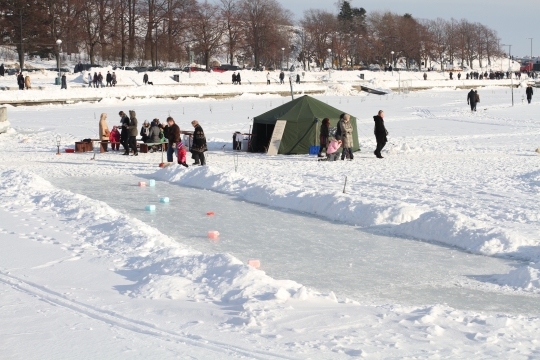
Temporary cafe set up on the ice... and curling sheet!
One of the delightful things about northern cities is the degree to which their geography changes during winter. Helsinki comes alive with recreational opportunities all across the frozen sea. Suddenly the isolated boat gas station becomes a winter cafe, with a new arrival path across the iced-over harbor. Remote coffee shops have new streams of guests who come to roast sausages on outdoor fire pits. Or have a curling match. This won't last for too much longer, given the warm weather we've been having, so I'll have to wait for next year to corral my colleagues into starting the Sitra Curling team.
Week 102 closes with a steady hum—and the clickety clack of more writing.
